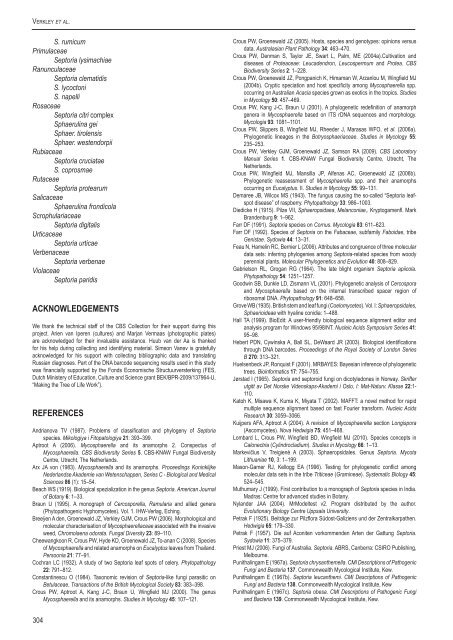A new approach to species delimitation in Septoria - CBS - KNAW
A new approach to species delimitation in Septoria - CBS - KNAW
A new approach to species delimitation in Septoria - CBS - KNAW
Create successful ePaper yourself
Turn your PDF publications into a flip-book with our unique Google optimized e-Paper software.
Verkley et al.S. rumicumPrimulaceaeSep<strong>to</strong>ria lysimachiaeRanunculaceaeSep<strong>to</strong>ria clematidisS. lycoc<strong>to</strong>niS. napelliRosaceaeSep<strong>to</strong>ria citri complexSphaerul<strong>in</strong>a geiSphaer. tirolensisSphaer. westendorpiiRubiaceaeSep<strong>to</strong>ria cruciataeS. coprosmaeRutaceaeSep<strong>to</strong>ria protearumSalicaceaeSphaerul<strong>in</strong>a frondicolaScrophulariaceaeSep<strong>to</strong>ria digitalisUrticaceaeSep<strong>to</strong>ria urticaeVerbenaceaeSep<strong>to</strong>ria verbenaeViolaceaeSep<strong>to</strong>ria paridisACKNOWLEDGEMENTSWe thank the technical staff of the <strong>CBS</strong> Collection for their support dur<strong>in</strong>g thisproject. Arien van Iperen (cultures) and Marjan Vermaas (pho<strong>to</strong>graphic plates)are acknowledged for their <strong>in</strong>valuable assistance. Huub van der Aa is thankedfor his help dur<strong>in</strong>g collect<strong>in</strong>g and identify<strong>in</strong>g material. Simeon Vanev is gratefullyacknowledged for his support with collect<strong>in</strong>g bibliographic data and translat<strong>in</strong>gRussian diagnoses. Part of the DNA barcode sequenc<strong>in</strong>g results used <strong>in</strong> this studywas f<strong>in</strong>ancially supported by the Fonds Economische Structuurversterk<strong>in</strong>g (FES,Dutch M<strong>in</strong>istery of Education, Culture and Science grant BEK/BPR-2009/137964-U,“Mak<strong>in</strong>g the Tree of Life Work”).REFERENCESAndrianova TV (1987). Problems of classification and phylogeny of Sep<strong>to</strong>ria<strong>species</strong>. Mikologiya i Fi<strong>to</strong>pa<strong>to</strong>logiya 21: 393–399.Aptroot A (2006). Mycosphaerella and its anamorphs 2. Conspectus ofMycosphaerella. <strong>CBS</strong> Biodiversity Series 5. <strong>CBS</strong>-<strong>KNAW</strong> Fungal BiodiversityCentre, Utrecht, The Netherlands.Arx JA von (1983). Mycosphaerella and its anamorphs. Proceed<strong>in</strong>gs Kon<strong>in</strong>klijkeNederlandse Akademie van Wetenschappen, Series C - Biological and MedicalSciences 86 (1): 15–54.Beach WS (1919). Biological spezialization <strong>in</strong> the genus Sep<strong>to</strong>ria. American Journalof Botany 6: 1–33.Braun U (1995). A monograph of Cercosporella, Ramularia and allied genera(Phy<strong>to</strong>pathogenic Hyphomycetes). Vol. 1. IHW-Verlag, Ech<strong>in</strong>g.Breeÿen A den, Groe<strong>new</strong>ald JZ, Verkley GJM, Crous PW (2006). Morphological andmolecular characterisation of Mycosphaerellaceae associated with the <strong>in</strong>vasiveweed, Chromolaena odorata. Fungal Diversity 23: 89–110.Cheewangkoon R, Crous PW, Hyde KD, Groe<strong>new</strong>ald JZ, To-anan C (2008). Speciesof Mycosphaerella and related anamorphs on Eucalyptus leaves from Thailand.Persoonia 21: 77–91.Cochran LC (1932). A study of two Sep<strong>to</strong>ria leaf spots of celery. Phy<strong>to</strong>pathology22: 791–812.Constant<strong>in</strong>escu O (1984). Taxonomic revision of Sep<strong>to</strong>ria-like fungi parasitic onBetulaceae. Transactions of the British Mycological Society 83: 383–398.Crous PW, Aptroot A, Kang J-C, Braun U, W<strong>in</strong>gfield MJ (2000). The genusMycosphaerella and its anamorphs. Studies <strong>in</strong> Mycology 45: 107–121.Crous PW, Groe<strong>new</strong>ald JZ (2005). Hosts, <strong>species</strong> and genotypes: op<strong>in</strong>ions versusdata. Australasian Plant Pathology 34: 463–470.Crous PW, Denman S, Taylor JE, Swart L, Palm, ME (2004a).Cultivation anddiseases of Proteaceae: Leucadendron, Leucospermum and Protea. <strong>CBS</strong>Biodiversity Series 2: 1–228.Crous PW, Groe<strong>new</strong>ald JZ, Pongpanich K, Himaman W, Arzanlou M, W<strong>in</strong>gfield MJ(2004b). Cryptic speciation and host specificity among Mycosphaerella spp.occurr<strong>in</strong>g on Australian Acacia <strong>species</strong> grown as exotics <strong>in</strong> the tropics. Studies<strong>in</strong> Mycology 50: 457–469.Crous PW, Kang J-C, Braun U (2001). A phylogenetic redef<strong>in</strong>ition of anamorphgenera <strong>in</strong> Mycosphaerella based on ITS rDNA sequences and morphology.Mycologia 93: 1081–1101.Crous PW, Slippers B, W<strong>in</strong>gfield MJ, Rheeder J, Marasas WFO, et al. (2006a).Phylogenetic l<strong>in</strong>eages <strong>in</strong> the Botryosphaeriaceae. Studies <strong>in</strong> Mycology 55:235–253.Crous PW, Verkley GJM, Groe<strong>new</strong>ald JZ, Samson RA (2009). <strong>CBS</strong> Labora<strong>to</strong>ryManual Series 1. <strong>CBS</strong>-<strong>KNAW</strong> Fungal Biodiversity Centre, Utrecht, TheNetherlands.Crous PW, W<strong>in</strong>gfield MJ, Mansilla JP, Alfenas AC, Groe<strong>new</strong>ald JZ (2006b).Phylogenetic reassessment of Mycosphaerella spp. and their anamorphsoccurr<strong>in</strong>g on Eucalyptus. II. Studies <strong>in</strong> Mycology 55: 99–131.Demaree JB, Wilcox MS (1943). The fungus caus<strong>in</strong>g the so-called “Sep<strong>to</strong>ria leafspotdisease” of raspberry. Phy<strong>to</strong>pathology 33: 986–1003.Diedicke H (1915). Pilze VII, Sphaeropsidaea, Melanconiae,. Kryp<strong>to</strong>gamenfl. MarkBrandenburg 9: 1–962.Farr DF (1991). Sep<strong>to</strong>ria <strong>species</strong> on Cornus. Mycologia 83: 611–623.Farr DF (1992). Species of Sep<strong>to</strong>ria on the Fabaceae, subfamily Faboidae, tribeGenistae. Sydowia 44: 13–31.Feau N, Hamel<strong>in</strong> RC, Bernier L (2006). Attributes and congruence of three moleculardata sets: <strong>in</strong>ferr<strong>in</strong>g phylogenies among Sep<strong>to</strong>ria-related <strong>species</strong> from woodyperennial plants. Molecular Phylogenetics and Evolution 40: 808–829.Gabrielson RL, Grogan RG (1964). The late blight organism Sep<strong>to</strong>ria apiicola.Phy<strong>to</strong>pathology 54: 1251–1257.Goodw<strong>in</strong> SB, Dunkle LD, Zismann VL (2001). Phylogenetic analysis of Cercosporaand Mycosphaerella based on the <strong>in</strong>ternal transcribed spacer region ofribosomal DNA. Phy<strong>to</strong>pathology 91: 648–658.Grove WB (1935). British stem and leaf fungi (Coelomycetes). Vol. I: Sphaeropsidales,Sphaerioideae with hyal<strong>in</strong>e conidia: 1–488.Hall TA (1999). BioEdit: A user-friendly biological sequence alignment edi<strong>to</strong>r andanalysis program for W<strong>in</strong>dows 95/98/NT. Nucleic Acids Symposium Series 41:95–98.Hebert PDN, Cyw<strong>in</strong>ska A, Ball SL, DeWaard JR (2003). Biological identificationsthrough DNA barcodes. Proceed<strong>in</strong>gs of the Royal Society of London SeriesB 270: 313–321.Huelsenbeck JP, Ronquist F (2001). MRBAYES: Bayesian <strong>in</strong>ference of phylogenetictrees. Bio<strong>in</strong>formatics 17: 754–755.Jørstad I (1965). Sep<strong>to</strong>ria and sep<strong>to</strong>roid fungi on dicotyledones <strong>in</strong> Norway. Skrifterutgitt av Det Norske Videnskaps-Akademi i Oslo, I: Mat-Naturv. Klasse 22:1-110.Ka<strong>to</strong>h K, Misawa K, Kuma K, Miyata T (2002). MAFFT: a novel method for rapidmultiple sequence alignment based on fast Fourier transform. Nucleic AcidsResearch 30: 3059–3066.Kuijpers AFA, Aptroot A (2004). A revision of Mycosphaerella section Longispora(Ascomycetes). Nova Hedwigia 75: 451–468.Lombard L, Crous PW, W<strong>in</strong>gfield BD, W<strong>in</strong>gfield MJ (2010). Species concepts <strong>in</strong>Calonectria (Cyl<strong>in</strong>drocladium). Studies <strong>in</strong> Mycology 66: 1–13.Markevičius V, Treigienė A (2003). Sphaeropsidales. Genus Sep<strong>to</strong>ria. MycotaLithuaniae 10, 3: 1–199.Mason-Gamer RJ, Kellogg EA (1996). Test<strong>in</strong>g for phylogenetic conflict amongmolecular data sets <strong>in</strong> the tribe Triticeae (Gram<strong>in</strong>eae). Systematic Biology 45:524–545.Muthumary J (1999). First contribution <strong>to</strong> a monograph of Sep<strong>to</strong>ria <strong>species</strong> <strong>in</strong> India.Madras: Centre for advanced studies <strong>in</strong> Botany.Nylander JAA (2004). MrModeltest v2. Program distributed by the author.Evolutionary Biology Centre Uppsala University.Petrak F (1925). Beiträge zur Pilzflora Südost-Galiziens und der Zentralkarpathen.Hedwigia 65: 179–330.Petrak F (1957). Die auf Aconiten vorkommenden Arten der Gattung Sep<strong>to</strong>ria.Sydowia 11: 375–379.Priest MJ (2006). Fungi of Australia. Sep<strong>to</strong>ria. ABRS, Canberra: CSIRO Publish<strong>in</strong>g,Melbourne.Punithal<strong>in</strong>gam E (1967a). Sep<strong>to</strong>ria chrysanthemella. CMI Descriptions of PathogenicFungi and Bacteria 137. Commonwealth Mycological Institute, Kew.Punithal<strong>in</strong>gam E (1967b). Sep<strong>to</strong>ria leucanthemi. CMI Descriptions of PathogenicFungi and Bacteria 138. Commonwealth Mycological Institute, KewPunithal<strong>in</strong>gam E (1967c). Sep<strong>to</strong>ria obesa. CMI Descriptions of Pathogenic Fungiand Bacteria 139. Commonwealth Mycological Institute, Kew.304
















